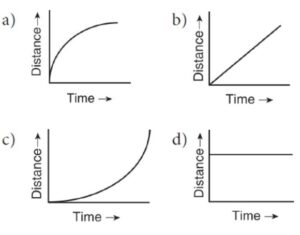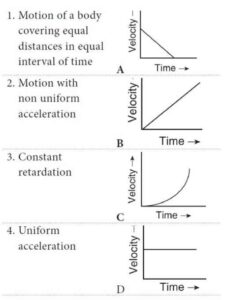support@techeditz2utnpsc.com | 8300-921-521

Motion
Samacheer Book Back Questions And Answers For Science Standard 9 “Motion“
I. Choose the correct answer:
1. The area under velocity – time graph represents the
(a) velocity of the moving object.
(b) displacement covered by the moving object.
(c) speed of the moving object.
(d) acceleration of the moving object.
2. Which one of the following is most likely not a case of uniform circular motion?
(a) Motion of the Earth around the Sun.
(b) Motion of a toy train on a circular track.
(c) Motion of a racing car on a circular track.
(d) Motion of hours’ hand on the dial of the clock.
3. Which of the following graph represents uniform motion of a moving particle?

Answer: (b)
4. The centrifugal force is
(a) a real force.
(b) the force of reaction of centripetal force.
(c) a virtual force.
(d) directed towards the centre of the circular path.
II. Fill in the blanks:
1. Speed is a _____ quantity whereas velocity is a _____ quantity.
2. The slope of the distance – time graph at any point gives.
3. Negative acceleration is called _____.
4. Area under velocity – time graph shows _____.
Answers:
1. Scalar, Vector
2. Speed
3. retardation (or) deceleration
4. displacement
III. State whether true or false. If false, correct the statement:
1. The motion of a city bus in a heavy traffic road is an example for uniform motion.
2. Acceleration can get negative value also.
3. Distance covered by a particle never becomes zero but displacement becomes zero.
4. The velocity – time graph of a particle falling freely under gravity would be a straight line parallel to the x axis.
5. If the velocity – time graph of a particle is a straight line inclined to X-axis then its displacement – time graph will be a straight line.
Answers:
1. False (The motion of a city bus in a heavy traffic road is an example for non-uniform motion)
2. True
3. True
4. False (The velocity – time graph of a particle moving at uniform velocity, would be straight line parallel to the x axis)
5. True
IV. Assertion and reason type questions:
1. Assertion: The accelerated motion of an object may be due to change in magnitude of velocity or direction or both of them.
Reason: Acceleration can be produced only by change in magnitude of the velocity. It does not depend the direction.
(a) If both assertion and reason are true and reason is the correct explanation of assertion.
(b) If both assertion and reason are true but reason is not the correct explanation of assertion.
(c) If assertion is true but reason is false.
(d) If assertion is false but reason is true.
2. Assertion: The Speedometer of a car or a motor-cycle measures its average speed.
Reason: Average velocity is equal to total displacement divided by total time taken.
(a) If both assertion and reason are true and reason is the correct explanation of assertion.
(b) If both assertion and reason are true but reason is not the correct explanation of assertion.
(c) If assertion is true but reason is false.
(d) If assertion is false but reason is true.
3. Assertion: Displacement of a body may be zero when distance travelled by it is not zero.
Reason: The displacement is the shortest distance between initial and final position.
(a) If both assertion and reason are true and reason is the correct explanation of assertion.
(b) If both assertion and reason are true but reason is not the correct explanation of assertion.
(c) If assertion is true but reason is false.
(d) If assertion is false but reason is true.
V. Match the Following:

Answers:
1. B
2. C
3. A
4. D
Visit Our YouTube Channel For More Free Videos: Click Here


